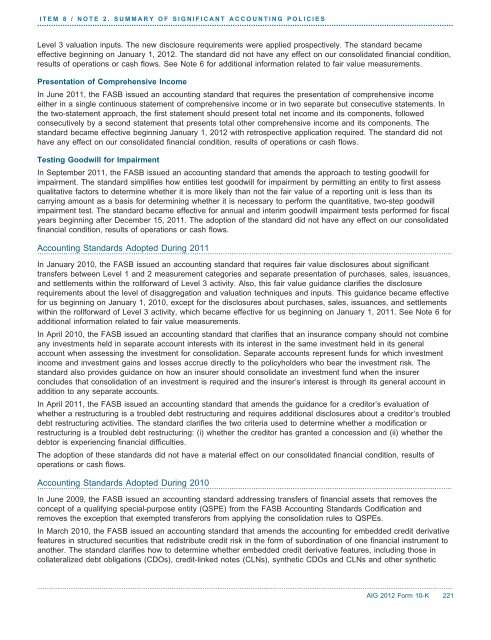Bring on tomorrow - AIG.com
Bring on tomorrow - AIG.com
Bring on tomorrow - AIG.com
Create successful ePaper yourself
Turn your PDF publications into a flip-book with our unique Google optimized e-Paper software.
ITEM 8 / NOTE 2. SUMMARY OF SIGNIFICANT ACCOUNTING POLICIES.....................................................................................................................................................................................Level 3 valuati<strong>on</strong> inputs. The new disclosure requirements were applied prospectively. The standard becameeffective beginning <strong>on</strong> January 1, 2012. The standard did not have any effect <strong>on</strong> our c<strong>on</strong>solidated financial c<strong>on</strong>diti<strong>on</strong>,results of operati<strong>on</strong>s or cash flows. See Note 6 for additi<strong>on</strong>al informati<strong>on</strong> related to fair value measurements.Presentati<strong>on</strong> of Comprehensive In<strong>com</strong>eIn June 2011, the FASB issued an accounting standard that requires the presentati<strong>on</strong> of <strong>com</strong>prehensive in<strong>com</strong>eeither in a single c<strong>on</strong>tinuous statement of <strong>com</strong>prehensive in<strong>com</strong>e or in two separate but c<strong>on</strong>secutive statements. Inthe two-statement approach, the first statement should present total net in<strong>com</strong>e and its <strong>com</strong>p<strong>on</strong>ents, followedc<strong>on</strong>secutively by a sec<strong>on</strong>d statement that presents total other <strong>com</strong>prehensive in<strong>com</strong>e and its <strong>com</strong>p<strong>on</strong>ents. Thestandard became effective beginning January 1, 2012 with retrospective applicati<strong>on</strong> required. The standard did nothave any effect <strong>on</strong> our c<strong>on</strong>solidated financial c<strong>on</strong>diti<strong>on</strong>, results of operati<strong>on</strong>s or cash flows.Testing Goodwill for ImpairmentIn September 2011, the FASB issued an accounting standard that amends the approach to testing goodwill forimpairment. The standard simplifies how entities test goodwill for impairment by permitting an entity to first assessqualitative factors to determine whether it is more likely than not the fair value of a reporting unit is less than itscarrying amount as a basis for determining whether it is necessary to perform the quantitative, two-step goodwillimpairment test. The standard became effective for annual and interim goodwill impairment tests performed for fiscalyears beginning after December 15, 2011. The adopti<strong>on</strong> of the standard did not have any effect <strong>on</strong> our c<strong>on</strong>solidatedfinancial c<strong>on</strong>diti<strong>on</strong>, results of operati<strong>on</strong>s or cash flows.Accounting Standards Adopted During 2011..............................................................................................................................................................................................In January 2010, the FASB issued an accounting standard that requires fair value disclosures about significanttransfers between Level 1 and 2 measurement categories and separate presentati<strong>on</strong> of purchases, sales, issuances,and settlements within the rollforward of Level 3 activity. Also, this fair value guidance clarifies the disclosurerequirements about the level of disaggregati<strong>on</strong> and valuati<strong>on</strong> techniques and inputs. This guidance became effectivefor us beginning <strong>on</strong> January 1, 2010, except for the disclosures about purchases, sales, issuances, and settlementswithin the rollforward of Level 3 activity, which became effective for us beginning <strong>on</strong> January 1, 2011. See Note 6 foradditi<strong>on</strong>al informati<strong>on</strong> related to fair value measurements.In April 2010, the FASB issued an accounting standard that clarifies that an insurance <strong>com</strong>pany should not <strong>com</strong>bineany investments held in separate account interests with its interest in the same investment held in its generalaccount when assessing the investment for c<strong>on</strong>solidati<strong>on</strong>. Separate accounts represent funds for which investmentin<strong>com</strong>e and investment gains and losses accrue directly to the policyholders who bear the investment risk. Thestandard also provides guidance <strong>on</strong> how an insurer should c<strong>on</strong>solidate an investment fund when the insurerc<strong>on</strong>cludes that c<strong>on</strong>solidati<strong>on</strong> of an investment is required and the insurer’s interest is through its general account inadditi<strong>on</strong> to any separate accounts.In April 2011, the FASB issued an accounting standard that amends the guidance for a creditor’s evaluati<strong>on</strong> ofwhether a restructuring is a troubled debt restructuring and requires additi<strong>on</strong>al disclosures about a creditor’s troubleddebt restructuring activities. The standard clarifies the two criteria used to determine whether a modificati<strong>on</strong> orrestructuring is a troubled debt restructuring: (i) whether the creditor has granted a c<strong>on</strong>cessi<strong>on</strong> and (ii) whether thedebtor is experiencing financial difficulties.The adopti<strong>on</strong> of these standards did not have a material effect <strong>on</strong> our c<strong>on</strong>solidated financial c<strong>on</strong>diti<strong>on</strong>, results ofoperati<strong>on</strong>s or cash flows.Accounting Standards Adopted During 2010..............................................................................................................................................................................................In June 2009, the FASB issued an accounting standard addressing transfers of financial assets that removes thec<strong>on</strong>cept of a qualifying special-purpose entity (QSPE) from the FASB Accounting Standards Codificati<strong>on</strong> andremoves the excepti<strong>on</strong> that exempted transferors from applying the c<strong>on</strong>solidati<strong>on</strong> rules to QSPEs.In March 2010, the FASB issued an accounting standard that amends the accounting for embedded credit derivativefeatures in structured securities that redistribute credit risk in the form of subordinati<strong>on</strong> of <strong>on</strong>e financial instrument toanother. The standard clarifies how to determine whether embedded credit derivative features, including those incollateralized debt obligati<strong>on</strong>s (CDOs), credit-linked notes (CLNs), synthetic CDOs and CLNs and other synthetic..................................................................................................................................................................................................................................<strong>AIG</strong> 2012 Form 10-K 221
















